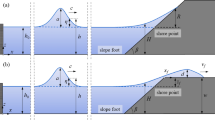Abstract
This paper presents a local tsunami simulation, including the initial displacement field model of tsunami source and tsunami wave propagation model. We deduced the tsunami wave equation; applied the matching of interior and exterior solutions method and water mass method to determine the initial displacement field in different bottom topography. Tsunami wave propagation model was based on the Boussinesq equation. Difference format was based on the ADI method which discretized in alternating direction in the form of implicit scheme. The open boundary of ADI had been revised considering the influence of wave propagation in the equation of motion. The local tsunami mathematical model was used in the simulation of 2011 Japan tsunami, and the results and the observation data match well.
Similar content being viewed by others
References
Cochard R, Ranamukhaarachchi S L, Shivakoti G P, et al. 2008. The 2004 tsunami in Aceh and Southern Thailand: A review on coastal ecosystems, wave hazards and vulnerability. Perspectives in Plant Ecology, Evolution and Systematics, 10(1): 3–40
Darienzo M, Aya A, Crawford G L, et al. 2005. Local Tsunami warning in the Pacific coastal United States. Natural Hazards, 35(1): 111–119
Frolov A V, Kamaev D A, Martyshchenko V A, et al. 2012. Experience of the Russian tsunami warning system updating. Russian Meteorology and Hydrology, 37(6): 357–368
Geist E L, Titov V V, Arcas D, et al. 2007. Implications of the 26 December 2004 Sumatra–Andaman earthquake on tsunami forecast and assessment models for great subduction–zone earthquakes. Bulletin of the Seismological Society of America, 97(1A): S249–S270
Grilli S T, Harris J C, Tajalli Bakhsh T S, et al. 2013. Numerical simulation of the 2011 Tohoku Tsunami based on a new transient FEM co–seismic source: comparison to far-and near-field observations. Pure and Applied Geophysics, 170(6–8): 1333–1359
Grilli S T, Taylor O D S, Baxter C D P, et al. 2009. A probabilistic approach for determining submarine landslide tsunami hazard along the upper east coast of the United States. Marine Geology, 264(1–2): 74–97
Igarashi Y, Kong L, Yamamoto M, et al. 2011. Anatomy of Historical Tsunamis: lessons learned for tsunami warning. Pure and Applied Geophysics, 168(11): 2043–2063
Jaffe B E, Gelfenbuam G. 2007. A simple model for calculating tsunami flow speed from tsunami deposits. Sedimentary Geology, 200(3–4): 347–361
Jing Huimin, Zhang Huai, Wu Zhongliang, et al. 2013. Tsunami constraints on finite fault models: the March 11, 2011 Tohoku earthquake. Earthquake (in Chinese), 33(4): 207–213
Li Daming, Fu Qingjun, Lin Yi. 2009. Research on the local tsunami wave propagation mathematical model. Ocean Technology (in Chinese), 28(1): 60–65
McCreery C S. 2005. Impact of the national tsunami hazard mitigation program on operations of the richard H. Hagemeyer Pacific Tsunami warning center. Natural Hazards, 35(1): 73–88
Qian Weichang. 1981. Singular Perturbation Theory and Its Applications in Mechanics (in Chinese). Beijing: Science Press, 87–131
Ren Zhiyuan, Wang Benlong, Fan Tingting, et al. 2013. Numerical analysis of impacts of 2011 Japan Tohoku tsunami on China Coast. Journal of Hydrodynamics, Ser B, 25(4): 580–590
Simons M, Minson S E, Sladen A, et al. 2011. The 2011 magnitude 9. 0 Tohoku–Oki earthquake: mosaicking the megathrust from seconds to centuries. Science, 332(6036): 1421–1425
Szczucinski W. 2012. The post-depositional changes of the onshore 2004 tsunami deposits on the Andaman Sea coast of Thailand. Natural Hazards, 60(1): 115–133
Tychsen J, Geertz-Hansen O, Schjøth S. 2008. KenSea-tsunami damage modelling for coastal areas of Kenya. Geological Survey of Denmark and Greenland Bulletin, 15: 85–88
Wang Peitao, Yu Fujiang, Zhao Lianda, et al. 2012. Numerical analysis of tsunami propagating generated by the Japan Mw9. 0 earthquake on Mar. 11 in 2011 and its impact on China coasts. Chinese Journal of Geophysics (in Chinese), 55(9): 3088–3096
Wijetunge J J. 2009. Field measurements and numerical simulations of the 2004 tsunami impact on the south coast of Sri Lanka. Ocean Engineering, 36(12–13): 960–973
Xue Hongchao, Gu Jialong, Ren Rushu. 1980. Coastal Dynamics. Beijing: China Communications Press (in Chinese), 286–306
Yan Zhenzhen, Zhang Huai, Fan Xiangtao, et al. 2014. Comparative analysis of the characteristics of global seismic wave propagation excited by the Mw 9. 0 Tohoku earthquake using numerical simulation. Science China Earth Sciences, 57(7): 1626–1636
Yuan Chuguang, Wang Yigang, Huang Huiming, et al. 2013. Impact of “311” Japan tsunami on northern Jiangsu coast. The Ocean Engineering (in Chinese), 31(6): 68–75
Author information
Authors and Affiliations
Corresponding author
Additional information
Foundation item: The National Natural Science Foundation of China under contract No. 51079095; the Science Fund for Creative Research Groups of the National Natural Science Foundation of China under contract No. 51021004.
Rights and permissions
About this article
Cite this article
Li, D., Li, Y. A mathematical model of calculating local tsunami wave source constraints and propagation. Acta Oceanol. Sin. 34, 103–109 (2015). https://doi.org/10.1007/s13131-015-0673-0
Received:
Accepted:
Published:
Issue Date:
DOI: https://doi.org/10.1007/s13131-015-0673-0




